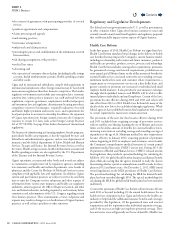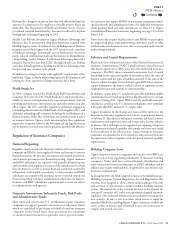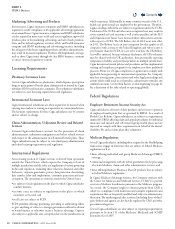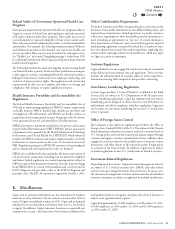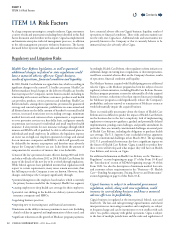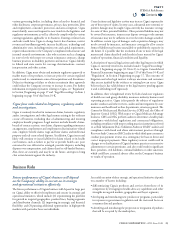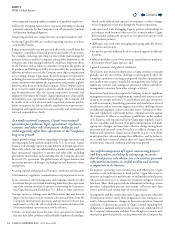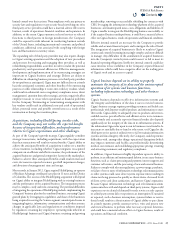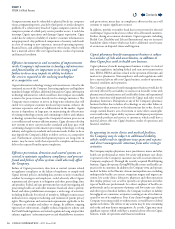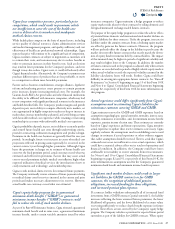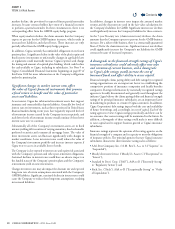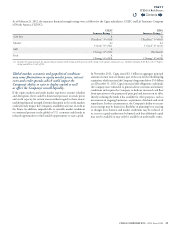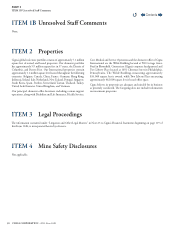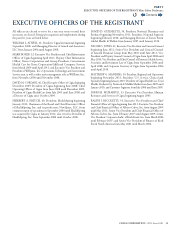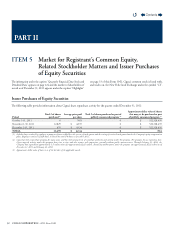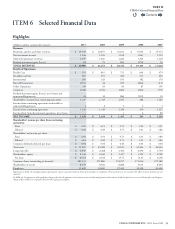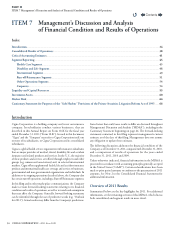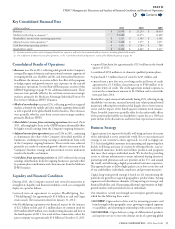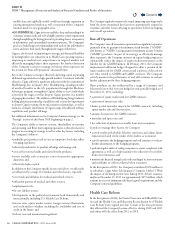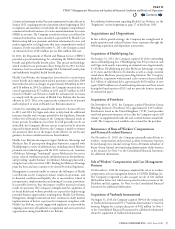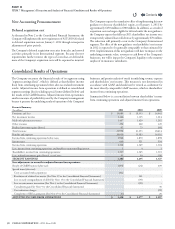Cigna 2011 Annual Report Download - page 50
Download and view the complete annual report
Please find page 50 of the 2011 Cigna annual report below. You can navigate through the pages in the report by either clicking on the pages listed below, or by using the keyword search tool below to find specific information within the annual report.
28 CIGNA CORPORATION2011 Form10K
PARTI
ITEM 1A Risk Factors
markets decline, the provision for expected future partial surrenders
increases, because contract holders have more of a nancial incentive
to perform a partial surrender. In these circumstances, there is no
corresponding oset from the GMDB equity hedge program.
When equity markets decline, the claim amounts that the Company
expects to pay out for the GMIB business increases, which results in
increased net liabilities and related losses. ese increases are only
partially oset from the GMIB equity hedge program.
In addition, Cigna currently has unfunded obligations in its frozen
pension plans. A signicant decline in the value of the plan’s equity and
xed income investments or unfavorable changes in applicable laws
or regulations could materially increase Cigna’s expenses and change
the timing and amount of required plan funding, which could reduce
the cash available to Cigna, including its subsidiaries. See Note9 to
Cigna’s Consolidated Financial Statements beginning on page87 of
this Form10-K for more information on the Company’s obligations
under the pension plan.
Significant changes in market interest rates affect
the value of Cigna’s financial instruments that promise
a fixed return or benefit and the value of particular
assets and liabilities.
As an insurer, Cigna has substantial investment assets that support
insurance and contractholder deposit liabilities. Generally low levels of
interest rates on investments, such as those experienced in UnitedStates
nancial markets during recent years, have negatively impacted the level
of investment income earned by the Company in recent periods, and
such lower levels of investment income would continue if these lower
interest rates were to continue.
Substantially all of the Company’s investment assets are in xed
interest-yielding debt securities of varying maturities, xed redeemable
preferred securities and commercial mortgage loans. e value of
these investment assets can uctuate signicantly with changes in
market conditions. A rise in interest rates could reduce the value of
the Company’s investment portfolio and increase interest expense if
Cigna were to access its available lines of credit.
e Company is also exposed to interest rate and equity risk associated
with the Company’s pension and other post-retirement obligations.
Sustained declines in interest rates could have an adverse impact on
the funded status of the Company’s pension plans and the Company’s
reinvestment yield on new investments.
Changes in interest rates may also impact the discount rate and expected
long-term rate of return assumptions associated with the Company’s
GMDB liabilities. Signicant, sustained declines in interest rates could
cause the Company to reduce these long-term assumptions, resulting
in increased liabilities.
In addition, changes in interest rates impact the assumed market
returns and the discount rate used in the fair value calculations for
the Company’s liabilities for GMIB. Signicant interest rate declines
could signicantly increase the Company’s liabilities for these contracts.
As the 7-year Treasury rate (claim interest rate) declines, the claim
amounts that the Company expects to pay out for the GMIB business
increases. For a subset of the business, there is a contractually guaranteed
oor of 3% for the claim interest rate. Signicant interest rate declines
could signicantly increase the Company’s net liabilities for GMIB
contracts because of increased exposures.
A downgrade in the financial strength ratings of Cigna’s
insurance subsidiaries could adversely affect new sales
and retention of current business, and a downgrade
in Cigna’s debt ratings would increase the cost of
borrowed funds and affect ability to access capital.
Financial strength, claims paying ability and debt ratings by recognized
rating organizations are an important factor in establishing the
competitive position of insurance companies and health benets
companies. Ratings information by nationally recognized ratings
agencies is broadly disseminated and generally used throughout the
industry. Cigna believes the claims paying ability and nancial strength
ratings of its principal insurance subsidiaries are an important factor
in marketing its products to certain of Cigna’s customers. In addition,
Cigna Corporation’s debt ratings impact both the cost and availability
of future borrowings, and accordingly, its cost of capital. Each of the
rating agencies reviews Cigna’s ratings periodically and there can be
no assurance that current ratings will be maintained in the future. In
addition, a downgrade of these ratings could make it more dicult
to raise capital and to support business growth at Cigna’s insurance
subsidiaries.
Insurance ratings represent the opinions of the rating agencies on the
nancial strength of a company and its capacity to meet the obligations
of insurance policies. e principal agencies that rate Cigna’s insurance
subsidiaries characterize their insurance rating scales as follows:
•
A.M. Best Company,Inc. (“A.M. Best”), A++ to S (“Superior” to
“Suspended”);
•
Moody’s Investors Service (“Moody’s”), Aaa to C (“Exceptional” to
“Lowest”);
•
Standard & Poor’s Corp. (“S&P”), AAA to R (“Extremely Strong”
to “Regulatory Action”); and
•
Fitch,Inc. (“Fitch”), AAA to D (“Exceptionally Strong” to “Order
of Liquidation”).
Contents
Q


